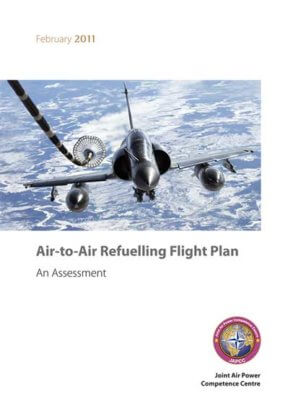Background
During the Cold War the requirement for AAR was limited to the support of long-range strategic forces as many NATO Nations, certainly the European members, worked under the assumption that their respective Armed Forces would operate very close to home. Post the end of the Cold War, NATO has been increasingly engaged in Expeditionary Operations (EO), and in training and exercises, beyond its traditional North Atlantic geographical domain. As a consequence there has been an increased requirement for AAR in order to satisfy a greater number of receivers at extended ranges. However as nations purchased new receiver-capable aircraft there was no corresponding increase in AAR assets. In 2002, this overall shortfall of AAR was recognised by NATO in the Prague Capabilities Commitment (PCC).
Current NATO policy holds individual nations ultimately responsible for the training, maintenance and deployment of their forces to and from an Area of Operations. AAR is critical to both the success of the deployment and any concurrent operations; to deploy the forces in a timely manner, in minimising both the logistical footprint and the chances of ground aborts during transits, and in maintaining a high tempo of operations. With the challenges associated with EO, AAR’s role as a Force Multiplier has become increasingly important.
Aim
The AAR Flight Plan is a source document aimed at informing the wider NATO Alliance that establishes guidelines for improving AAR interoperability between nations. This Flight Plan reviews current NATO AAR capabilities, identifies problems in standardisation and discusses future considerations. This document will also present a catalogue of current and future NATO AAR assets, examining a broad range of issues likely to impact future Alliance AAR planning and execution. It endeavours to increase awareness and, ultimately, standardisation and interoperability across the Alliance.
Scope
The AAR Flight Plan combines studies previously carried out by the JAPCC, and updates the findings of those studies. The equipment, resources and systems covered include all AAR aircraft, and the systems that support them, including mission planning, basing and training. Issues are examined and discussed under the categories of effects, resources, future requirements, future employment concepts, additional roles and steps taken to enhance AAR Interoperability. However this document is by no means prescriptive and does not serve as a panacea to address all issues.
Assumptions and Limitations
This Flight Plan is based on the following assumptions:
- Tanker Aircraft are national assets, under national command and control. This includes civilian tankers contracted by a nation or nations.
- NATO has no AAR assets of its own, but national assets can be provided for the benefit of NATO upon national approval.
- During crises and conflicts, Transfer of Authority (TOA) of AAR assets will follow the NATO generation of forces procedure.
- Agreements between providers and receivers are driven by bilateral Memoranda of Understanding (MOU). Legal, financial, technical and operational specifics must be coordinated between nations for each combination of tankers and receivers, even when operating as NATO TOA assets.
- NATO’s capability to influence national policy and shape current and future AAR issues is limited. NATO influence is restricted to the NATO Defence Planning Process (NDPP), where NATO, through its mechanism for Defence Requirements Review (DRR), can influence (or encourage) nations to prioritise their investments. Alliance priorities and Standardisation Agreements (STANAGs) are considerations, but nations acquire and operate weapon systems on the basis of national interests and priorities.
Authority
The authors of this Flight Plan are AAR Subject Matter Experts (SMEs) working in the NATO AAR Coordination Cell (AARCC), Combat Support Branch, at the JAPCC. This AAR office was initially established in 2001 as a result of MCM 217(98)1. Manpower constraints within the NATO Commands resulted in the NATO AARCC being formed within the Reaction Force Air Staff (RFAS) at Kalkar. In 2004, the functions of RFAS were no longer relevant in the newly transforming NATO structure, and therefore, it was disestablished. In its place, the JAPCC was formed in 2005 with an office consisting of AAR SMEs, based on the model of the AARCC. Additionally, JAPCC confirmed that it would continue carrying out the functions of the AARCC and accordingly submitted to ACT a revision of MCM 2172. Furthermore, as the AAR SMEs were already in post, the JAPCC decided that one of its first transformation projects delivered to HQ Allied Command Transformation (ACT) would be “Enhancing NATO AAR Interoperability”. This project is covered in detail in Chapter 7 of this Flight Plan, but in summary, it is a 10 year project improving NATO interoperability by developing Allied Tactical Publications (ATPs) and STANAGs. The JAPCC AAR SMEs continue to advise NATO on a wide range of AAR matters, and the office remains the only one in NATO dedicated to AAR issues and staffed by AAR SMEs.
Classification
This report is not classified. Information from classified sources and references are not cited or referenced in this report. Discussions, findings, and recommendations are not based on classified information. Reference to classified sources may be required to support more detailed discussions and recommendations that go beyond the information, discussion and recommendations presented here.











